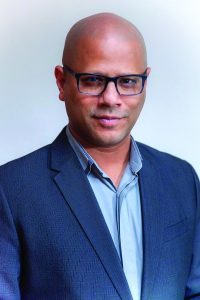
In his more than 20 years in academia, artist Hasan Elahi has come to a simple conclusion: Few people understand higher education.
“It’s a very cryptic system,” he said.
As a core faculty member at the School of Art this season, Elahi has been working with students and emerging artists with academic interests to develop teaching strategies that incorporate their individual artistic practices.
“My job here is to help demystify the entire system for these artists,” he said.
Elahi, a professor and the director of the School of Art at George Mason University, will be closing out this season’s Visual Arts Lecture Series with a talk at 7 p.m. Friday, August 2 in the Hultquist Center.
During his lecture, he hopes to give Chautauquans a look into his process as an artist and teacher. He describes his practice as being more directed by ideas than any single medium.
“I think historically, a lot of artists and a lot of people who come to the arts expect us to be working from a specific material or a specific medium,” he said. “Often that’s the first or second thing that one is asked when you identify as an artist. (People ask), ‘Oh, what medium?’ And for many of us, (we) don’t necessarily follow a traditional model.”
He believes artists have a duty to use their work to reflect the realities of their time.
“If you think about it … whether you go back to Rembrandt paintings or … cave paintings, all art was contemporary art at one time,” he said. “Artists would often depict what was happening in their society in that work. If you look at what’s happening in society today and in my lifetime, there’s a lot of topics that keep coming up.”
His work focuses on topics like immigration, citizenship, borders and surveillance, as well as the integration of military technology into civilian life.
“The relationship of warfare and technology is something that’s at the forefront in my work,” he said.
Elahi said his course at the School of Art is especially important because many of the students and emerging artists are in or preparing to enter graduate school, and will likely be put into teaching positions with little preparation.
“Most schools operate like, ‘Here’s your syllabus, go teach your class, … figure it out,’ ” he said.
He hopes that equipping artists with a better understanding of the education system and teaching methods will ultimately produce a greater diversity of artistic practices.
“In the arts, we have this tendency to really teach from what our teachers taught us,” Elahi said. “Because so much of art teaching is based on practice, it tends to perpetuate a very specific type of practice. We’re trying to get our students to think, not just from a material-(based) practice, but from their ideas.”




